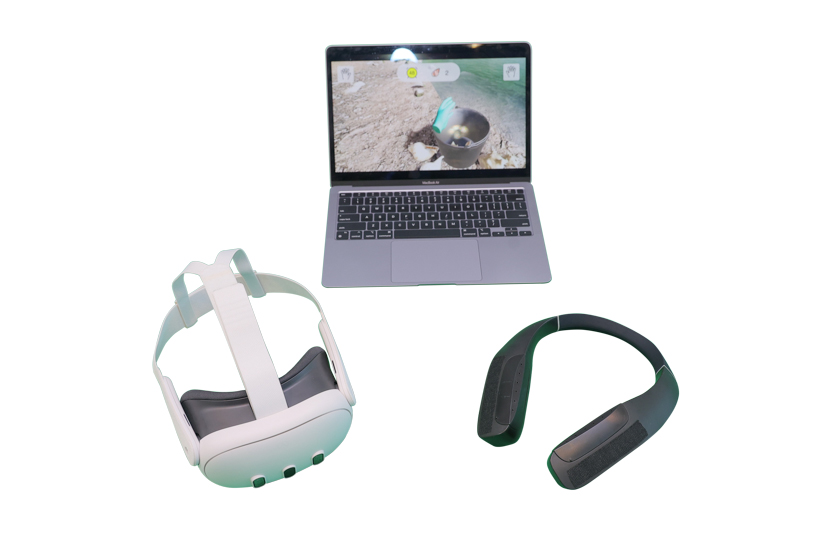AI驱动的多感官虚拟现实疗法
用户痛点
该计画解决了老年人和有心理健康问题的人面临的挑战,包括难以获得透过嗅觉刺激进行体力活动、认知训练和心理健康的综合多感官治疗。这些用户的痛点包括难以获得全面的多感官治疗方案:包括针对身体活动、认知训练和心理健康的嗅觉刺激治疗。一般社区的老年用户缺乏长期服务的设备和平台。这些可以透过此方案及人工智慧应用程式来解决。从护理人员的角度来看,该项目减少管理工作并节省时间,同时也提供了包括运动追踪在内的即时远端监控系统,并提供一体化解决方案,增强了可访问性,提供全面的支持,并改善了主要使用者和护理人员的维护成本。
方案裨益
使用者可以从全方位的训练中获益,这些训练包括与文化相关的活动,他们可以透过在家进行的定期训练来积极参与并提供便利性。它提供一个安全且受控的环境,随时随地都可使用。提供个性化的训练以满足个人需求,并进行长期数据追踪和调整。该解决方案适用於广泛的人群,包括健康的老年人、心理健康问题人士以及住院和门诊患者。此外,它还可以通过远程康复使一位专家可以协助多个使用者,促进高效且易於接触的护理。这些功能提升使用者体验,并为社区的福祉做出贡献。
科技应用
这是一款创新且全面的一体化应用程序,结合了 VR 技术、多感官刺激(包括嗅觉元素)、AI 演算法、运动追踪、远端复健、云端运算和遊戏化。它让使用者沉浸在引人入胜的虚拟环境中,而多感官刺激则增强了治疗潜力。旨在增强身体活动、认知训练和心理健康。它提供了一系列模组,包括嗅觉多感官方法、个人化人工智慧生成的功能以及 IADL 任务、园艺活动和自然疗法等治疗内容。 这方案利用机器学习和运动追踪等尖端技术来提供客製化体验和自适应马达控制功能。凭藉跨平台相容性,它可以透过颈掛式嗅觉装置、VR 或基於萤幕的装置进行存取。遊戏化创造了引人入胜且激励人心的体验。该应用程式提供了一种突破性的方法,旨在简化医疗保健、改善福祉并满足用户(包括老龄化人口)的多样化需求。
目标用户(内容只提供英文版)
用户特徵描述:
Age Group:
Primarily elderly(65+), Some middle-aged adults(40-64)
Occupation:
Mostly retired. Some still working part-time/volunteering
Psychographics:
a) Values health and well-being
b) Seeks to maintain independence
c) Interested in non-pharmacological therapies
d) May feel isolated/disconnected
e) Desires mental stimulation and engagement
f) Open to trying new technologies with support
g) May have limited mobility/sensory capabilities
h) Seeks activities that improve quality of life
Living Situation:
a) Independent living
b) Assisted living facilities
c) Nursing homes
d) With family caregivers
Health Status:
a) Managing chronic conditions
b) Recovering from injuries/surgeries
c) Dealing with age-related decline
d) Coping with mental health challenges
使用场景和目标:
Users engage with multisensory technology across various settings, from private homes to healthcare facilities. They participate in immersive experiences tailored to their needs, including virtual cognitive and physical therapy, and relaxation programs. It aims to enhance mental acuity, improve physical function, reduce stress, and increase social engagement. It offers personalized, adaptive interventions in safe, controlled environments. Users seek to maintain independence, enhance motor and cognitive functions, stimulate neural plasticity, and improve well-being. The system tracks progress, allowing for continual adjustment of treatment plans. Ultimately, it provides an accessible, engaging alternative to traditional therapies, enhancing quality of life for diverse users.

